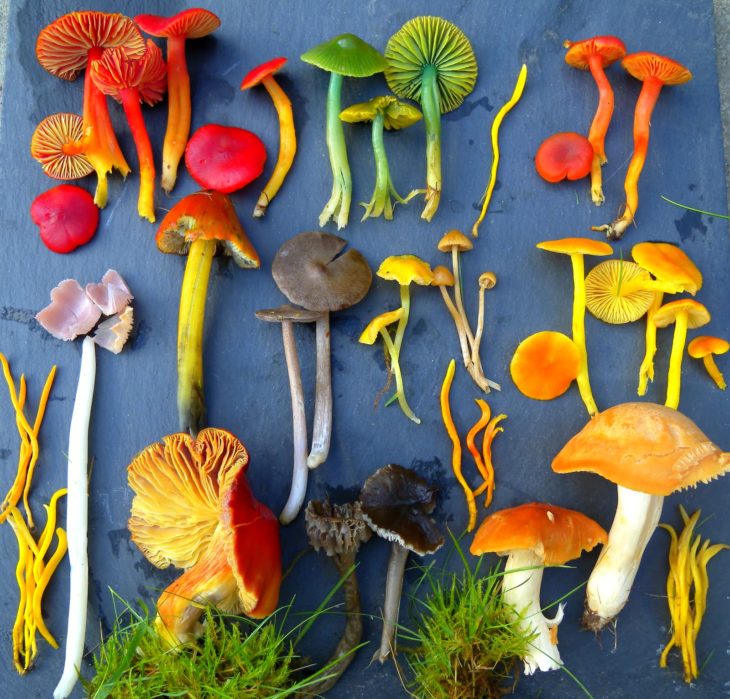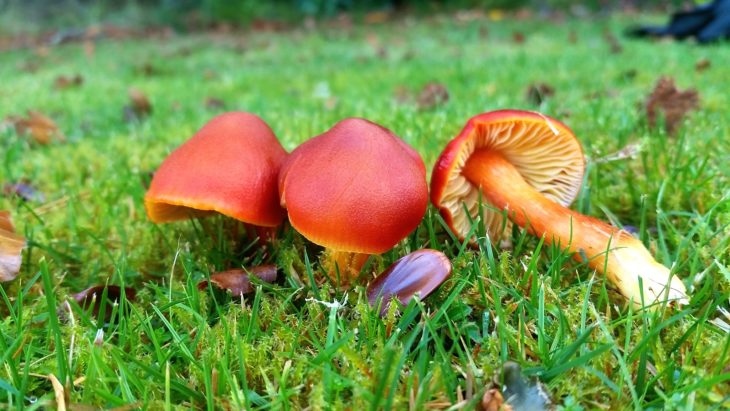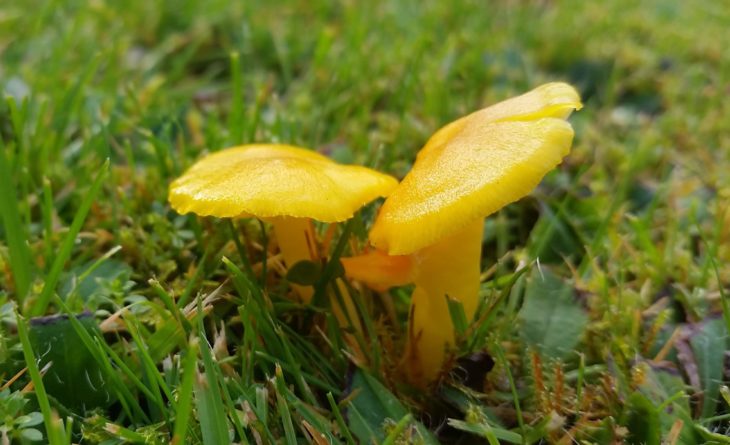Waxcaps: Scotland’s fungi jewels
Waxcaps are colourful fungi that thrive on ancient grasslands and are among the Trust’s Priority Species. In this guest blog Dr David Genney from Scottish Natural Heritage explains their appeal, and what can be done to help protect them.
For me, waxcaps include some of the finest jewels amongst Scotland’s fungi. These colourful mushrooms are named after the thick waxy gills that hang hidden below their caps. They come in a rainbow of colours from rich scarlets and lemon yellow to purples and green. This rich palette is reflected in their common names, for example, scarlet waxcap, crimson waxcap, pink waxcap, snowy waxcap and parrot waxcap.
Some species also have distinctive smells such as honey or fresh pencil shavings! I am always excited when I discover these beautiful fungi and never tire of photographing them. These enigmatic fungi are usually found along with a suite of other types of fungi, which include colourful clubs, spindles, corals, pinkgills and earthtongues.

The scarlet waxcap (left) is one of our most striking waxcaps while the green parrot waxcap (centre) can be quite well camouflaged. The pink waxcap (right) is one of the most elegant mushrooms you’ll see.
Waxcaps were once included in a single group (genus) of fungi with the scientific name ‘Hygrocybe’, however recent genetic studies have resulted in a number of species being moved into different closely related groups. They are all still called waxcaps, however, so let’s not complicate things further!
Waxcap fungi are found throughout Scotland and are primarily associated with grassland, as in other parts of Europe. These include unimproved pastures, lawns, montane and coastal grassland. They will sometimes crop up in woodlands too but are much less common here. In contrast, in North America woodland is the primary habitat for many of our grassland waxcaps, a strange observation that doesn’t appear to have been explained as yet. We still have a lot to learn about other aspects of waxcap ecology. We don’t know what these fungi feed on, which is quite important when it comes to their conservation. A recent study has suggested they get their sugars from live plants and nitrogen from an animal source, however the precise mechanisms are still to be resolved.
Some species are relatively common and even occur in disturbed and enriched-amenity grassland in towns and cities. However, diverse ‘waxcap grassland’ is only found in low nutrient sites that haven’t been disturbed for many years. A typical garden lawn, such as mine in the Highlands, that has been mown but not trampled or fertilised for 40 years or so, might be lucky enough to contain four or five different species.
Older lawns, for example those that surround many of Scotland’s castles and stately homes and are over 100 years old, might support 10 to 15 different species. Our richest waxcap grassland, however, is found in our upland low-intensity pastures where 20 or more different species of waxcap can be recorded from a single site. This includes the Lui Flats near Braemar where 19 species have been recorded, and the grassland around Rassal in the NW Highlands, where an amazing 27 species of waxcap have been recorded.
Old lawns are one of the best places to find grassland fungi, as this collection from an historic castle lawn illustrates.

Britain has a significant proportion of high diversity waxcap grassland when compared to other European countries. According to one measure of waxcap grassland diversity, there are at least 150 nationally important sites in Britain, compared to 20 in Denmark and 14 in the Netherlands.
Unfortunately, in many parts of Britain, including some areas of Scotland, there appear to have been significant losses of rich waxcap grassland sites. There have been historic and ongoing losses of unimproved grassland due to agricultural improvements such as addition of fertilisers, lime additions, tilling and re-seeding. In some areas a reduction in grazing by sheep or rabbits has resulted in grasses becoming tall or being replaced by scrub, which seems to result in the loss of waxcap mushrooms.
Losses in other parts of Europe may have been even more severe, for example in The Netherlands, where thousands of square kilometres of unimproved grassland are thought to have been lost since the beginning of the 20th century. Fortunately, we think that upland areas of Scotland have been subject to fewer changes and, indeed, there are likely to be many more diverse waxcap sites yet to be discovered here.
There is clearly a need to identify and protect our most important waxcap grassland sites. However, this isn’t straight forward because fungi are primarily below-ground organisms. Many waxcap fungi produce their fruitbodies infrequently or only for a short period of time each year. As such it can take many visits over a number of years to capture a site’s full diversity. Rich waxcap sites can easily be dismissed, and even damaged, simply because the fungi were not visible at the time of assessment.
Nevertheless, in 2009 the Joint Nature Conservancy Council published the UK’s first guidelines for the selection of Sites of Special Scientific Interest (SSSIs) for grassland fungi and have, this year, updated them in their new guidelines, which cover a range of other fungal habitats and assemblages. This has resulted in grassland fungi being listed as protected features on two SSSIs in Scotland – Eastern Cairngorms SSSI and Morrone Birkwood SSSI – and gives us a standard by which to compare other sites.
Many other important waxcap sites receive some protection through the notification of their grassland habitats; however, there is no direct link between plant diversity and waxcap diversity so some sites with low plant diversity have excellent waxcap diversity. In addition, the management requirements for plants don’t always match the requirements of fungi.

Recent advances in techniques to detect fungi in soil via their DNA hold great promise for waxcap conservation. Unlike their mushrooms the below-ground mycelium (the name given to the network of long thread-like fungal cells) is far more persistent. This means that, with a careful sampling design, we can capture a more accurate picture of the diversity of species at a site from a single soil survey. Collecting soil samples for DNA analysis is also a less specialised task because it doesn’t require the ability to identify the many different species from their mushrooms.
Given the relatively small pool of expert field mycologists this will greatly improve our capacity to survey and monitor sites. The speed and portability of DNA analysis is improving all the time while, importantly, the costs are decreasing. The potential for wide-scale survey and monitoring of waxcap sites isn’t far away and this will provide invaluable information for future site protection and management.
There are plenty of things you can do to help identify and protect important waxcap fungal sites. If you own or manage grazing land be aware that some unimproved pasture could be ancient and rich in waxcaps and so will be damaged by fertilisers, tilling and re-seeding. Consider commissioning a professional survey or inviting your local fungus group along to help you assess the value of your grassland.
Likewise, if you have a lawn, no matter how big, try to avoid the temptation to fertilise it or to treat with chemicals to remove moss. Remove the clippings when you mow and try to keep some areas free from trampling.
If you don’t have a lawn, consider joining your local fungus group and learning more about these wonderful species. This way you might be able to identify new important waxcap sites and thereby help secure their protection.
There are still plenty of opportunities to see waxcaps this year, as they will continue to produce mushrooms until regular winter frosts set in. Enjoy!

Help protect Scotland’s wildlife
Our work to save Scotland’s wildlife is made possible thanks to the generosity of our members and supporters.
Join today from just £4 a month to help protect the species you love.
Preface
Waxcaps are colourful fungi that thrive on ancient grasslands and are among the Trust’s Priority Species. In this guest blog Dr David Genney from Scottish Natural Heritage explains their appeal, …
